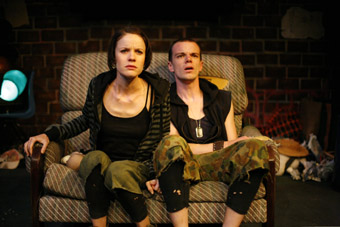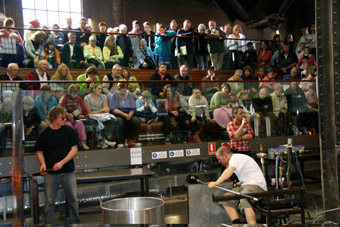new seeding
robyn archer: canberra performance series, part 3

Elizabeth Haslam, James O’Connell, Hoods, Street Theatre/NORPA
photo Lorna Sim
Elizabeth Haslam, James O’Connell, Hoods, Street Theatre/NORPA
FESTIVALS, ESPECIALLY THOSE IN THEIR INFANCY, AND MAJOR EVENTS LIKE ANNIVERSARIES CAN LEAVE PROFOUND LEGACIES: THIS IS THE OFTEN UNDER-VALUED POWER OF EPHEMERAL ART. ANTHONY STEEL’S NEW MEMOIR, PAINFUL IN DAILY DOSES (WAKEFIELD PRESS, ADELAIDE, 2009) CANDIDLY DESCRIBES HIS QUEENSLAND EXPO PROGRAM AS A BOX-OFFICE UNDER-ACHIEVER, YET POINTS OUT THAT IT WAS THE STIMULUS FOR A HUGE EXPANSION OF CULTURAL ACTIVITY THAT HAS SINCE DEVELOPED IN BRISBANE.
The other side of that major event coin is the sad tale told by a young theatre-maker from Porto: she claimed that her city’s year as European Capital of Culture had all but destroyed local arts and many young artists, herself included, had found it necessary to leave. Resources had all been corralled for that year’s boost and left little for ongoing activity in the years to follow.
As Gavin Findlay has suggested (RT 93, RT94), the National Festival of Australian Theatre and the Festival of Contemporary Arts both served as timely platforms for Canberra artists. Given their subsequent demise, we have to assume that neither event was given long enough to put down strong roots. The former had been Anthony’s brainchild and he gave it a point of difference by embracing one genre, liberally and laterally interpreted. Had the faith been maintained, the national capital would now be host not only to a much needed annual theatre conference, but also to one of the greatest gatherings of performing arts professionals in the world. The Australian Performing Arts Market began under my watch in Canberra and when the festival was canceled a couple of years later, the market followed me to Adelaide and has continued to flourish there. Such is the fate of short-term thinking.
Nevertheless, my take on Canberra at present is a positive one. While I was shocked to realise a couple of years ago that there had been a dramatic reduction in the number of professional companies resident there, all of whom I had invited in to the festival, what I now see is new energy and a burgeoning renaissance. The celebration of the Canberra Centenary in 2013 offers yet another timely opportunity to nurture and encourage that movement.
The Centenary program will be cultural in the broadest sense and will showcase Canberra as an incubator, rather than reinforce the misconception of it as a passive host to national government and collections. Science, sport, political and environmental concerns, the slow food movement etc, all deserve to be celebrated next to, and in collaboration with, the major cultural foci of design, architecture, city-planning, writing, film and sound, music, visual and performing arts, and all of this against the unique local, regional, national and international landscape of Canberra.
In 2011 we hope to announce a major hypothetical design exercise which will not only engage with fresh ideas nationwide about urban planning and city-scaping, but also ensure that the thinking that went into designing a new capital 100 years ago is brought into the present. It will highlight new concerns for building, environmental sustainability and their challenges to design as pure creativity.
In that unique mix of centenary programming sits a once-in-a-century opportunity to support local arts practice for the long term. Gavin is right to point out the dearth of arts training and a decline in resources for dance: they are things which need attention. But the first signs will come surprisingly soon. Flipart is a new addition to the Canberra Festival and will not only bring Stalker, Dislocate, Zimboyz and others for free street performances, but also ensure that visiting artists offer workshops. It will provide platforms for local artists such as Janine Ayres’ Aerial Dance and Warehouse Circus. With new initiatives this year, the period around Canberra Day (March 12th) is starting to gather the kind of critical mass which might soon be shaped into a festival of note in the ACT. One endearing aspect is a reminder that despite its national and international significance, Canberra is also a regional city: sheep-dog trials are still included in the program.
Other festivals with continuing grunt in the ACT include the Canberra International Music Festival, the National Folk Festival and the Canberra International Film Festival (a great 2009 program by Simon Weaving).
In the context of year-round activity, the Street Theatre can’t be underestimated. Caroline Stacey is providing exactly the kind of support emerging artists need and has created a process for local artists who are invited in, and mentored, to make their work. Aerial Dance’s The House that Jack Built was a standout, but new music theatre, poetry, music drama and a rap show produced by a couple of high school students were also part of Made in Canberra.This is an emerging artist program the Centenary will be keen to nurture. At the same time, Canberra Youth Theatre offers residencies to young artists, Min Mae is indeed leading the charge in live art, Jigsaw and QL2 still produce, CMAG and Craft ACT are devoted to local work, and barely a breath away the Q Theatre in Queanbeyan has a lively program.
If you add the outstanding exhibitions and public programs of our national collecting institutions housed there, and the speaker programs of ANU and Canberra University, their art, music and design schools, to say nothing of the programs of 100 diplomatic missions, there’s never a dull moment in the national capital. The brainfood is in staggering quantities and can feed myriad creativity.

Hotshop, Canberra Glassworks
The current Chief Minister, Jon Stanhope is also Arts Minister and a genuine supporter of the arts. His personal commitment to the excellent Glassworks, a new arts centre in Belconnen, and public artworks all over the city is testament to this. He is also a passionate supporter of the new International Arboretum, rising like a Phoenix from the burnt-out hillsides—100 forests of 100 trees and 100 gardens. All these initiatives offer platforms to a wide range of artists.
Stanhope’s endorsement of widespread reviews is an acknowledgment that this is a time for change. I don’t share Gavin’s view that this will mean just more bureaucracy. He may be right that some energies are, understandably, exhausted. But there are new ones a-foot and a-wing, especially for those keen to roll up their sleeves and work for the renaissance.
My mantra is seed now, flower in 2013, blossom for another 100 years. Canberra is not in-your-face like Sydney and Melbourne. Despite the myth of monumentalism, it’s a shy city, like its twin, the ancient Japanese capital of Nara, and that’s why I like it. Seek and ye shall find. I hope that those who cherish Canberra’s past, as Gavin Findlay clearly does, will have a happier song to sing of its future in a few years’ time.
The first two parts of our survey of the recent history of performance in Canberra were by Gavin Findlay (RT93; RT94)
RealTime issue #95 Feb-March 2010 pg. 12






